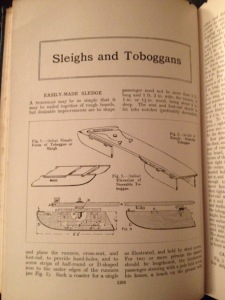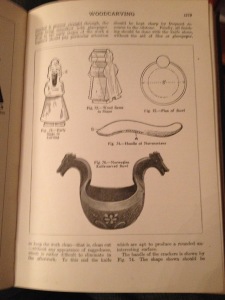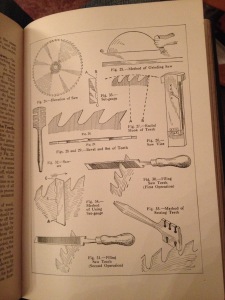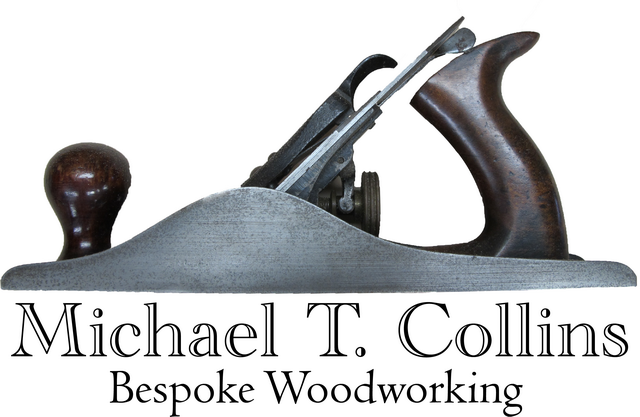 I was sorting through my woodworking library this week and came across the 4 volumes of Practical Woodworker magazine edited by Bernard E. Jones around 1916. The 4 volumes, some 1600 pages, was designed as a basic introduction to early 20th Century woodworking techniques. Jones put together the expansive woodworking knowledge and insight of 31 experts in the craft, providing an amazing resource for all things pertaining to woodworking.
I was sorting through my woodworking library this week and came across the 4 volumes of Practical Woodworker magazine edited by Bernard E. Jones around 1916. The 4 volumes, some 1600 pages, was designed as a basic introduction to early 20th Century woodworking techniques. Jones put together the expansive woodworking knowledge and insight of 31 experts in the craft, providing an amazing resource for all things pertaining to woodworking.
The impressive range of information covers the choice, use and maintenance of tools, instruction for joinery and other foundational techniques, furniture and fixtures for the shop, and projects and repair for the home.
The volumes are intended to instruct the reader to make it possible for any person to make any piece of woodwork by sound craftsman-like methods.
Jones himself says it best:
‘The Practical Woodworker is believed to be the most comprehensive and exhaustive book yet published on practical woodworking. And yet it does not attempt to give every detail of every aspect of woodworking, because only a library of books could do that. But it does attempt so to instruct the reader as to make it possible for any person, even for one who has never even seen a plane or driven a nail, to be able from this book alone to make any ordinary piece of woodwork by sound craftsman-like methods. The book assumes scarcely anything on the reader’s part, and it omits nothing essential. It leads the beginner forward, step by step, from simple and elementary tool processes to the construction of difficult and advanced pieces of work. Not only that, for every craftsman, no matter how expert, can learn something from its pages.”And indeed these volumes do just what they were designed to – with copious illustrations and related text they guide the woodworker into the wonderful realm or woodworking.
They are a fascinating history of methods and designs that a woodworker might make around the turn of the last century.
Volume 1: Mastering Tools and Materials – covers the workshop and its equipment, including shop appliances such as a saw bench, as well as the tools and foundation techniques of the trade: measuring and marking tools, saws and sawing, hammer and mallets, chisels and gouges, planes and planning, gluing, nailing and screwing and more. Plus, you will find techniques for making mouldings, cutting rabbets, making houses and lap joints, edge and angle joints, dovetails and more. It also includes some simple projects including plain tables, domestic woodenware, dog kennels, steps and ladders and more.
Volume 2: Indoor and Outdoor Woodwork – covers workbenches and tool chests, as well as a number of projects and techniques for the home and its environs, such as garden carpentry, trellises, porches, arbors, poultry houses, tubs and churns, as well as doors and windows and interior woodwork. Plus, you will find instruction on curved work and clamps, and plans for several bookcases dressers and sideboard.
Volume 3: Making Fine Furniture – covers instruction on building several furniture pieces, including chairs, cabinets, beds, a linen chest, upholstered pieces and even a billiard table.
Volume 4: Decorative Woodwork – covers some more advanced projects including a roll-top desk and other office furniture, sleighs and toboggans, mantel fittings and even aeroplane woodwork. Plus wood turning, veneering, inlay and marquetry, woodcarving, wood finishing, pattern-making and upholstery, as well as an early treatment of woodworking by machinery.
Here are a selection of pages from Volume 4
 It’s Winter, there’s no better time to build a toboggan |
 And of course every house needs a Norwegian carved bowl |
 The section on Woodworking by Machinery is fascinating! |
While I can sharpen plane and chisel blades, I am not sure that even with Jones’ expert advice, I have the skills necessary to sharpen a table saw blade.
Original editions are still available on Ebay once in a while and
The folks at Popular woodworking have published the 4 Volume set.
